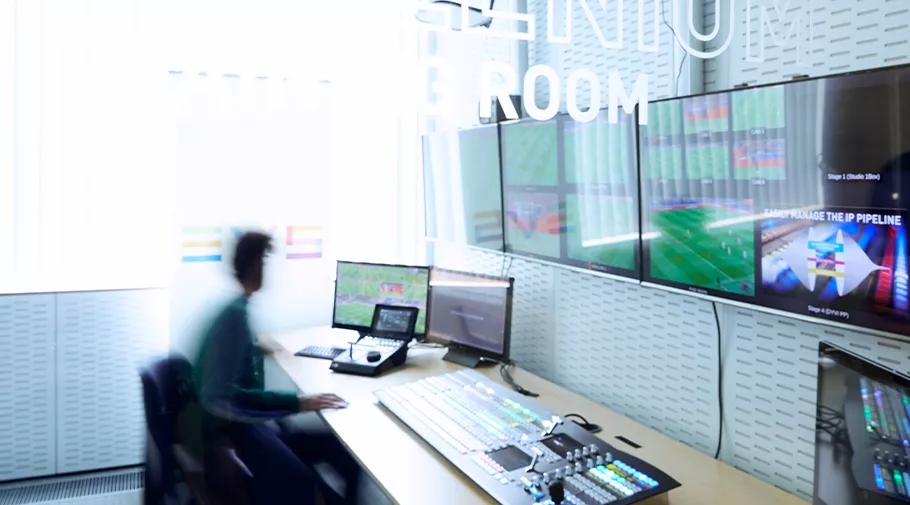MediaCeption Technical Training Tier 2
- Type

Training details
- Product Multiple products
- Category Workflows
4 days – this duration is given as indication (the exact duration of the training can vary according to the specificities of the customer setup and workflow)
English
This course is for engineers with on-the-field broadcasting experience that need to learn more about EVS technology and products involved in the MediaCeption solution. The objective of the training is to prepare them to deliver Tier 2 support tasks that include installation, configuration, monitoring and troubleshooting. Support procedures will also be included to enable the engineers to introduce issues by gathering relevant information and sharing it with EVS support teams
Technical managers and broadcast engineers with EVS experience
Have relevant broadcast experience in a technical function and attended the Basic Technical Training (Tier 1)
- Live Production Servers
• Refresher on the server hardware and software basic concepts
• General configuration: description of the different possibilities to configure the server (XNet monitor, web interface, console mode) and the different configuration tabs of the interface (general presentation and navigation, settings of the various tabs – server, channel, network, monitoring, protocols, GPI, Operations)
• LiveIP Configuration: description of the LiveIP interface and different settings
• XHub-VIA installation and configuration
• Description of some other advanced functions: debug pages from the console, Openmetrics monitoring
- IPDirector
• Refresher of the IPDirector architecture and its different components
• Installation and configuration exercises
• Description of some special modules such as Publish add-on
- VIA Xsquare
• Introduction and refresher of VIA Xsquare (main functions, concepts and terms, architecture XTAccess / VIA Xsquare, interface)
• VIA Xsquare configuration (orchestration and clustering rules, job templates, source/destination, encoder/wrapper profiles, icon and labels, scanfolders, dual orchestration and target configuration, …)
• Description of user, access and roles administration
• Service monitoring and troubleshooting
- Databases
• Refresher on the context & functional description
• Detailed description of backup and restore processes
• Detailed description of maintenance jobs, MSSQL management and advanced troubleshooting
- IPD-VIA
• Refresher on IPD-VIA: context of use, integration in MediaCeption solutions, presentation of IPD-VIA and VIA Apps
• Technical introduction of the system architecture, Docker containerization and Kubernetes orchestration, 3rd parties services
• Description of IPD-VIA installation: installation process, preparation of the installation, nodes installation, remote installer installation, installation of IPD-VIA Windows client application and Windows services
• Description of IPD-VIA configuration: user, system, Apps and infrastructure settings
• Monitoring and maintenance: refresher on VIA Trace and VIA Apps for monitoring purposes, configuration of VIA Trace, Grafana dashboard applied to IPD-VIA infrastructure, Lens for monitoring of Kubernetes control
- XS-NEO
• Refresher of the context of use and integration in MediaCeption solutions, description of the configuration interface and associated hardware
• Description of XS-NEO installation: preparation and installation process
• Description of XS-NEO configuration: I/O settings and playout & recorder channels
• LiveIP configuration: IP Multicast streaming, switching between SDI and IP mode, LiveIP interface (IP flow settings), configuration of related functions (PTP, ST2022-7, etc …)
• Monitoring and maintenance: presentation of Python and Shell scripts for various maintenance tasks, description of the platform console (health and metrics monitoring, restart services & dockers, download log files) and description of some debug functions on the user interfaces, monitoring and maintenance functions.
- Adobe IPLink
• Refresher on the configuration possibilities for Adobe IPLink and IPDirector/IPD-VIA integration description
- IPWeb
• Refresher on the functional description of IPWeb, the server configuration and IPDirector integration (API module configuration - requirements of indexing services and IPDirector API)
- Virtualization
• Presentation of virtualization principles (PMZ, third party)
• Description of restore process of VMs
• Description of monitoring possibilities
- EVS Maintenance tools
• Refresher on some maintenance tools such as XNet monitor, VGA viewer, IPD Cleaner, Lens, Prometheus and Grafana
- Support processes - Refresher
Provide an in-depth description of the tools used for customer support (production reports, customer database, customer support tool, EVS knowledge base) as well as related procedures.
• Description of the information to collect
• Description of ticket creation process on the Customer Portal
• Follow-up on tickets